The Study In Brief
COVID-19 vaccines, along with the emergence of less deadly variants of the disease, provided a route out of rotating lockdowns and ongoing uncertainty. Canada rapidly achieved some of the highest vaccination rates in the world following significant efforts to quickly develop, evaluate, procure, distribute and administer COVID-19 vaccines. As of Oct. 9, 2022, 80.3 percent of Canadians had completed a primary series of a vaccine (two doses) and half (49.6) percent had received at least one additional dose. Despite this success, there has been relatively little research evaluating the public health and economic effects associated with these mass vaccination efforts. This Commentary aims to address this gap by providing estimates of the cases, hospitalizations and deaths prevented by vaccination as well as the economic costs that could have occurred without vaccines.
Overall, our analysis shows vaccines were highly effective at reducing COVID-19 cases, hospitalizations and deaths – estimates suggest 21 percent fewer cases, 37 percent fewer hospitalizations and 34,900 fewer deaths (from January 2021 to May 2022). The direct cost of vaccine administration compared to the savings associated with averting missed work and treatment costs due to illness indicates an estimated net cost/benefit of –$0.4 billion to $2.1 billion. Using the statistical value of life, the estimated lives saved are valued at an additional $27.6 billion. In addition, vaccination allowed for a reduction in many preventative public health measures that disrupted the social and economic lives of Canadians. We model the macroeconomic effect of delayed access to vaccines and the continuation of public health restrictions. The results suggest that a six-month delay would have led to economic losses equivalent to about 12.5 percent of GDP, or about $156 billion in economic activity in 2021.
Vaccines were clearly economically and socially beneficial. The success of the COVID-19 mass vaccination campaign contains valuable insights for policy makers and health system administrators.
- Lockdowns were necessary to disrupt the spread of COVID-19 prior to vaccination, providing another pathway for reducing transmission. However, they had significant costs for the economy and the population’s mental health. Less disruptive public health interventions like recommending masks, physical distancing and increased sanitation are less costly. When lockdowns are necessary, implementing targeted restrictions by age group is less economically costly than uniform restrictions.
- The speed of development and distribution of not just one but many different vaccines for COVID-19 is truly an achievement. Rather than an average of more than 18 months from Health Canada approval to listing on public plans, COVID-19 vaccines took less than a year. Plus, regulatory changes allowed for ongoing submission of new clinical data and regulatory processes to occur in parallel. There are lessons to be learned about parallel regulatory steps, price negotiations and reducing the time-to-patient for innovative medical products.
- The success of the COVID-19 vaccination campaigns provides insights for other vaccination efforts, particularly for the working-age population. As policies adapt to the changing nature of COVID-19, there may be opportunities to link regular boosters with broader public health immunization and prevention efforts.
- Since COVID-19 vaccines show waning immunity over time, it is important to continue efforts to increase uptake of booster doses. The infectiousness of the Omicron variants means that COVID-19 will likely become endemic over time and regular booster doses will be required to maintain sufficient levels of population immunity.
The authors thank Jeremy Kronick, Charles DeLand, William Robson, Fred Horne and anonymous reviewers for comments on an earlier draft. The authors retain responsibility for any errors and the views expressed.
Introduction
To date, the COVID-19 pandemic in Canada has infected more than four million people and caused more than 46,000 deaths (as of Oct. 28, 2022).
More than 24.3 million Canadians (80.3 percent) have completed the primary series of the COVID-19 vaccination, and almost half of those have received at least one additional booster shot. Still, the pandemic and the associated restrictions on economic and social activities have massively disrupted the lives of Canadians. The arrival of vaccines provided a path to a new normalcy and enabled many social and economic activities to resume. Yet, despite widespread vaccination against COVID-19 in Canada, there is limited analysis quantifying its public health and economic effects.
This Commentary provides analysis to estimate the cases, hospitalizations and deaths averted by COVID-19 vaccination and its associated economic effects. First, we review the existing research on the pandemic’s effects and on public health restrictions and vaccination in Canada. Next, using COVID-19 case and weekly vaccination data, we model the number of cases that would have occurred in the absence of vaccination based on the relative number of cases between the unvaccinated and vaccine-eligible age groups. A similar statistical method is applied to estimate averted hospitalizations and deaths.
The following section provides a cost-benefit analysis of the direct effects of COVID-19 vaccines and a discussion of their indirect effects. The final section discusses the policy implications of our analysis.
Overall, the results show that vaccinations reduced the number of Canadian COVID-19 cases by about 21 percent and the number of hospitalizations by about 37 percent from the beginning of 2021 to May 2022. Furthermore, for the population over 50 years old, who are most at risk of severe outcomes from infection, vaccination reduced mortality by an estimated 63 percent – equivalent to 34,900 lives saved. In addition, about 65,000 cases of long COVID have been averted by vaccination.
Meanwhile, vaccine procurement and administration costs were some $3.7 billion, while the direct savings associated with averted cases and hospitalizations were an estimated $3.3 billion to $5.8 billion, resulting in a net cost-benefit estimate of -$0.4 billion to $2.1 billion, without considering the benefits of saved lives. The statistical value of reduced mortality
The indirect effects of vaccination are complex and interrelated with the effects of the pandemic and public health restrictions to control its spread. Ongoing mutations of the virus and adaptation of public health policies add to the complexity. While comprehensive analysis of the indirect effects of vaccination public health policies add to the complexity. While comprehensive analysis of the indirect effects of vaccination is beyond the scope of this study, we model the macroeconomic effect of delayed access to vaccines with different lockdown strategies (uniform or differentiated by age group). The results indicate that a six-month delay in vaccination and continuation of public health restrictions would have resulted in economic losses equivalent to about 12.5 percent of GDP. In 2021, this would have been about $156 billion in economic activity.
Furthermore, the arrival of vaccines coincided with a significant reduction in anxiety and depression in the population. The removal of public health restrictions and resumption of more regular economic activities is certainly linked to vaccination. While this study does not include these indirect effects in the cost-benefit analysis of the public health impact of vaccinations on the broader economy, they represent large and significant positive impacts.
Overall, the results show that vaccination was highly beneficial to population health and also cost-effective from an economic perspective. The rapid development, approval, procurement and distribution of vaccines was a success made possible because of proactive changes to regulatory and procurement processes that prioritized rapid access. This achievement provides insights about how to reform long-term regulatory processes to reduce delays in accessing new medical innovations. Furthermore, the wide success of the public health vaccination programs could provide insights for improving access to vaccinations for vulnerable populations and broader population immunization programs. For both managing the ongoing challenges of COVID-19 and for preparing governments for future infectious disease emergencies, it is important to understand the different effects of various public health policies and vaccination on population health and mortality, as well as on the economy.
Impact of Covid-19 Vaccinations on Public Health and Social and Economic Life
The COVID-19 pandemic has had unprecedented impacts on individuals and society. It not only continues to threaten public health, but also disrupts the social and economic lives of Canadians, in particular in the way they interact, learn, work and consume.
In the past two-and-half years, the Canadian economy experienced hundreds of billions of dollars in lost economic activity, directly or indirectly caused by the pandemic, in terms of border closures, healthcare expenditures, job losses and worsened mental health. Though the labour market and economy have in many ways recovered, the negative economic effects, particularly during the outset of the pandemic, were severe. In addition, the COVID-19 pandemic had a significant social impact. In 2020, Canadians reported the lowest levels of life satisfaction since 2003 (Statistics Canada 2020). The life expectancy also went down by 0.6 years, the largest decline in decades.
Beginning in March 2020, Canada’s federal and provincial governments enacted various policies to contain the spread of the virus. Such policies included lockdowns: closing borders, non-essential businesses, non-essential health services, child-care services and schools. International travel was banned for a while,
Evaluating the social, economic and health impacts of lockdowns and other public health measures is complicated. In the literature, many scholars found lockdowns to be effective in reducing COVID-19 cases and containing the spread of the virus (Friedson et al. 2020, Dave et al. 2021, Kharroubi and Saleh 2020, Poeschl and Larsen 2021). However, the impact of lockdowns on mortality is less certain. Allen (2021) examined 80 COVID-19 studies and concluded that lockdowns have had, at best, a marginal effect on the number of COVID-19 deaths. He argued, “Lockdown jurisdictions were not able to prevent non-compliance, and non-lockdown jurisdictions benefited from voluntary changes in behavior that mimicked lockdowns.” Herby, Jonung and Hanke (2022) further studied the effects of lockdowns on COVID-19 mortality rates. After systematically reviewing 18,590 studies, they identified 24 qualified empirical studies for meta-analysis. They then found that lockdowns have had little to no effect on COVID-19 mortality. As a result, they concluded that lockdowns are not an effective way of reducing mortality rates during a pandemic.
In terms of the indirect health impact of lockdowns, findings from Santabárbara et al. (2021) suggest that the global rates of anxiety more than tripled during the pandemic. Among 1,800 surveyed Canadians, nearly half reported high anxiety or depression levels due to lockdowns (Mental Health Research Canada 2020, 2021). Moreover, Plett, Pechlivanoglou and Coyte (2022) estimated a positive relationship between stay-at-home orders and anxiety symptom severity. Such anxiety was mainly driven by socio-demographic and socioeconomic factors such as fear of infection, financial and employment insecurity, housing instability and inability to access social support.
Between March and April 2020, lockdowns contributed to a 10.9-percent reduction in monthly GDP growth (Statistics Canada, June 2022). The public-health measures also caused temporary and permanent job losses, business bankruptcies, school closures, disruptions to healthcare delivery, supply-chain difficulties, and disturbed the flow of imports and exports in early 2020 (Statistics Canada 2020). Both business and consumer confidence indexes decreased to record-low levels compared to pre-COVID.
In order to mitigate the negative effects of lockdowns, Canadian governments provided many financial supports for employees and businesses. For example, the federal Canada Emergency Response Benefit was given to employees whose work was directly affected by COVID-19, while businesses were able to access wage subsidies, rent support and loan-payment deferrals.
In order to combat the spread of the virus, Canada approved six vaccines in 2020 and 2021, aiming to reach herd immunity. Vaccinating the majority of Canadians can help reduce infections, hospitalizations and deaths while also lowering economic and social costs. As of Oct. 9, 2022, 80.3 percent of Canadians had completed a primary series of a vaccine (two doses) and half (49.6 percent) had received at least one additional dose.
Many scholars have studied the effectiveness of COVID-19 vaccines. They have unanimously agreed upon their effectiveness in reducing cases, hospitalizations, and deaths, which range from 46.1 to 95.3, 63.5 to 97.5, and 69.3 to 96.7 percent, respectively, seven days or longer after the second dose (Haas et al. 2021, Bajema et al. 2021, Dagan et al. 2021, Griffin et al. 2021, Moghadas et al. 2021, Zaqouta et al. 2021). Bajema et al. (2021) found that mRNA vaccines remained highly effective during the spread of the Delta variant. For their part, Suthar et al. (2022) found that higher vaccination coverage rates were associated with reduced mortality and incidence rates from the Alpha and Delta variants.
In Ontario, meanwhile, Vilches et al. (2021) projected a 31.5-percent and 31.9-percent reduction in deaths thanks to Pfizer-BioNTech and Moderna vaccines, respectively. Barro (2022) observed a greater impact, indicating that a 14.2 percent increase in the vaccination rate can lower the death rate by 40.6 percent..
Vaccinations reduced infections, hospitalizations and deaths among residents and healthcare workers in Ontario’s long-term care (LTC) homes (Brown et al. 2021). Relative to unvaccinated healthcare workers and residents, COVID-19 infections decreased by 80 percent and 90 percent, respectively. The vaccination of LTC residents was estimated to prevent 2,079 cases, 249 hospitalizations and 615 deaths in Ontario.
COVID-19 vaccines not only reduce morbidity, hospitalizations and mortality, but also have secondary health impacts, reducing serious complications from COVID-19 infections.
Apart from improving health outcomes, vaccinations also have a positive economic impact. Averted health and societal costs from vaccinations are worth billions of dollars.
Most importantly, vaccination can alleviate the need for lockdowns and restrictive health measures. As we have witnessed since mass vaccination began – even with significant bumps along the way, e.g. Omicron – non-essential businesses reopened, shopping malls were crowded with consumers, cultural festivals and activities returned, social ties restored, unemployment rates decreased and routine medical procedures resumed. The economic and social lives of Canadians gradually recovered to pre-pandemic levels. Even though we continue to live with COVID-19 under the more transmissible Omicron variant, the threat of hospitalizations and deaths is less severe compared to previous variants.
However, the effectiveness of COVID-19 vaccines wanes over time. Cohn et al. (2022) compared the three types of vaccines and found that their overall protection against COVID-19 infection decreased from 89.2 percent in March 2021 to 13.1 percent just six months later. The decline was largest for the Johnson & Johnson vaccine, followed by Pfizer-BioNTech and Moderna. Barro (2022) also found that the positive effects of vaccinations on deaths, hospitalizations and cases diminished over time, especially during the emergence of the Omicron variant. One explanation is that the current vaccines are less effective against new forms of the virus (Barro 2022). Goldberg et al. (2021) and Cohn et al. (2022) echo this argument and suggest that vaccines are less effective in preventing Delta-related infections. Nevertheless, the vaccines are still effective against hospitalizations and deaths (Cohn et al. 2022, Vogel and Duong 2021).
As the virus evolves over time, the concern is around booster vaccines. From the literature, we know that the effectiveness of vaccines wanes in about six months. If new variants arise and population immunity diminishes, the lifesaving impact of vaccinations will fade. Canada is encouraging everyone who is eligible, but especially the elderly and other vulnerable groups, to take booster doses. Currently, about 56 percent of Canadians aged 12 and over have received the first booster dose. In terms of the second and third boosters, health experts have divided opinions. Some think that vaccines should focus on averted deaths, severe diseases and hospitalizations instead of infections in general. Others argue that it is better and more cost efficient to develop new variant-specific vaccines and more ethical to distribute surplus vaccines to other countries that still experience large numbers of COVID-related deaths (Duong and Vogel 2022). Both arguments are plausible since the pandemic is no longer a public health emergency in Canada, yet continues to be endemic.
Estimating the Vaccination Impact on COVID-19 Cases, Hospitalizations and Mortality
The effects of COVID-19, public health regulations to control it and vaccination efforts have all had complex and interrelated effects on the health of Canadians and the Canadian economy. Research mentioned in the previous section has used many different statistical methods and models to estimate the effects of COVID-19, related restrictions and vaccines. Some of these are forward-looking theoretical models of the economy and informed by the epidemiology of COVID-19, which were useful early in the pandemic to evaluate the potential effects of different lockdown strategies and different scenarios for combatting the spread of the virus (for example, Kronick and Jenkins 2021). This kind of modelling approach is most useful for forward-looking insights: what might happen, and if it does, what will the effects be?
Other modelling approaches use data generated throughout the pandemic to estimate the impacts and effectiveness of various interventions, assess the ongoing situation and retrospectively test different scenarios: what happened, what is happening, what would have happened if we did something different? (Tan et al. 2022). (See online Appendix for additional information on different modelling approaches used in published COVID-19 research.)
To assess the public-health effects of vaccination in Canada, we replicate and adapt the methods used by Tan et al. (2022). To estimate the number of averted cases, hospitalizations and deaths, we use publicly available weekly case-level data and counts of vaccination administrations (Public Health Agency of Canada 2022). Using Quasi-Poisson regressions, we estimated the number of COVID-19 cases by age group relative to a control group (0-19 years of age) during the pre-vaccination period (March 2020 to December 2020).
To assess the model, we performed various sensitivity checks. First, we re-estimated the model over the entire period by including variables for vaccination rates in both the control and dependent age groups. To simulate the scenario without vaccination, we predicted the number of COVID-19 cases (dependent variable), setting vaccination rates to zero for the target age group. In addition, we tested an expanded model including fixed effects for the circulating variant of COVID-19. For more information about the methods, analysis and data, see the online Appendix.
Overall, the estimated number of COVID-19 cases matches well with the actual case numbers until the end of 2021, where estimated cases and modelled cases diverge: the modelled case numbers are higher than confirmed case data would suggest. There are a number of potential explanations for this, but the most likely is a change in testing policy. Omicron overwhelmed clinical testing capacity in many regions, and provinces and territories reduced access to clinical testing, instead relying on other indicators (Statistics Canada 2022). In addition, the wide availability of rapid test kits for consumers likely resulted in a significant decline in the proportion of COVID-19 cases being officially reported to public health.
To account for this series break in reporting, we relied on research results using wastewater data to assess the concentration of COVID-19 in samples from different sites across the country (Nourbakhshet al. 2022). In cities, the number of cases estimated using wastewater data is much higher than clinically reported in January 2022 and again from April 2022 to May 2022 (Public Health Agency of Canada 2022). The ratio between clinical and wastewater estimates varies substantially across locations and across time, more closely matching clinical estimates when case numbers are low. When clinical cases of Omicron began to decline, wastewater estimates continued to increase in most locations, resulting in ratios between clinical and wastewater estimates ranging from 1:1.2
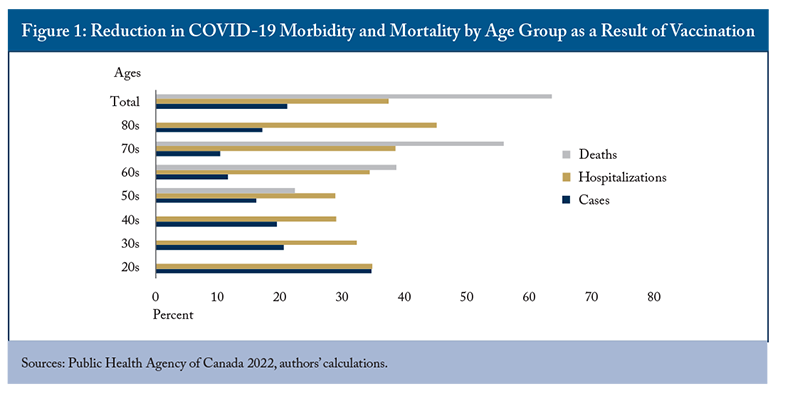
in Montreal to more than 1:6 in Vancouver by mid-January (Public Health Agency of Canada 2022).
Overall, the results show that vaccinations were associated with reducing the total number of Canadian COVID-19 cases by about 21 percent and the number of hospitalizations by about 37 percent from the beginning of 2021 to May 2022. Furthermore, for the population more than 50 years of age, who are most at risk of severe outcomes from infection, vaccination reduced mortality by an estimated 63 percent – equivalent to 34,900 lives saved (Figure 1). Vaccination was generally more effective for preventing infection for younger age groups than for older ones. It prevented more than a third of cases for the population age 20 to 29 and about a fifth for the population 30 to 49. Comparatively, about one in 10 cases in the population 60 to 79 were prevented by vaccination (Figure 2). Vaccination was most effective for preventing hospitalization of people more than 70 years of age (an estimated 38-percent reduction for the population 70 to 79 and a 45-percent reduction for the population more than 80), but was also quite effective for the younger population, preventing about 30 percent of hospitalizations in the non-senior population (Figure 3).
Similarly, vaccine effectiveness for preventing mortality increases with population age. Since older people were more likely to experience severe outcomes from COVID-19, the benefit of
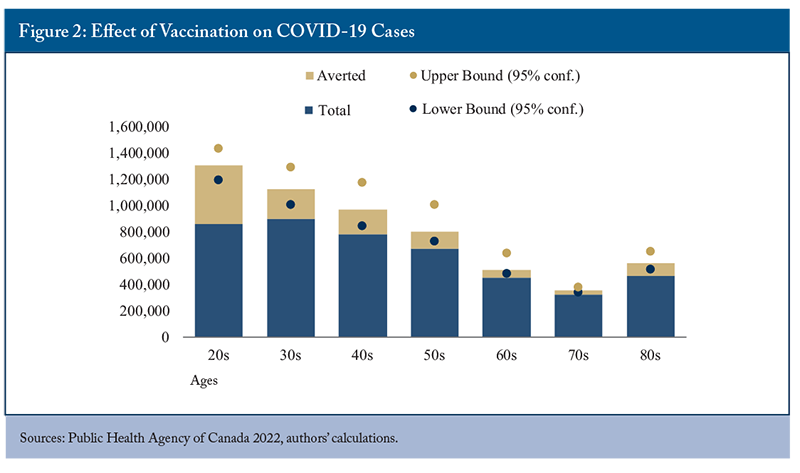
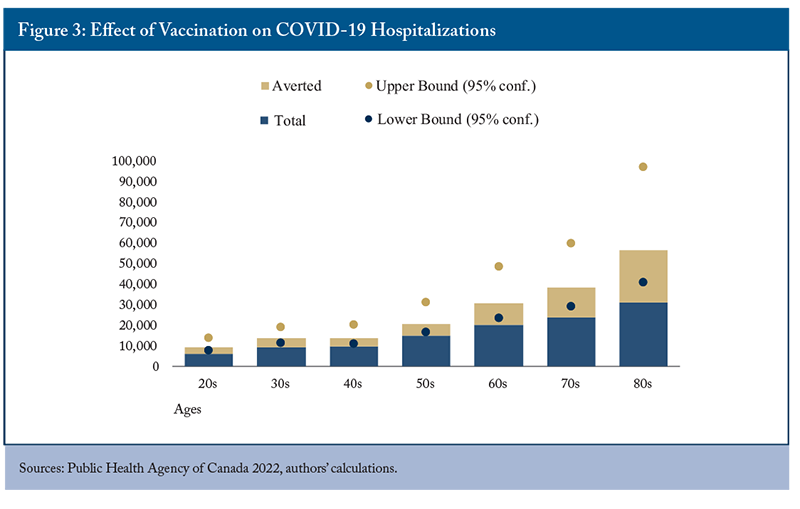
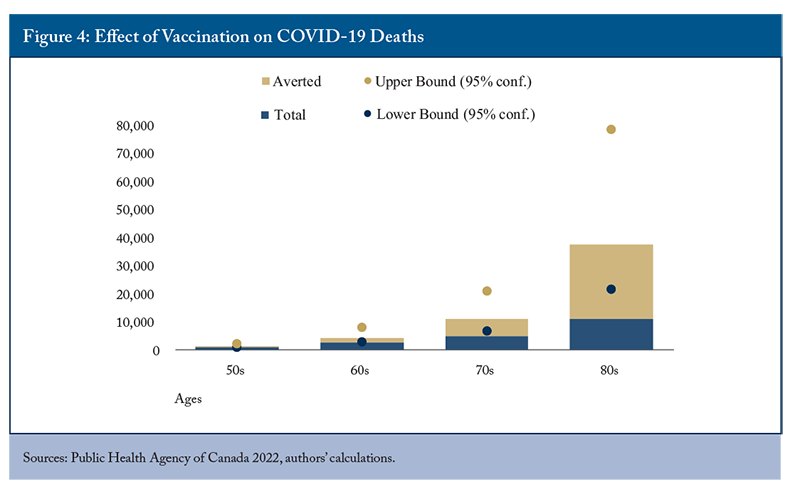
vaccination is proportionally larger than for younger people who are at lower risk (Figure 4).
Not all cases of COVID-19 resolve within three weeks – the World Health Organization estimates that at least 10 percent of people exhibit symptoms 12 weeks or longer after their initial diagnosis of COVID-19 (about 400,000 cases in Canada). There are more than 100 different symptoms associated with long COVID, the most common being fatigue, general pain, sleep disturbances, shortness of breath, cognitive impairment and mental-health symptoms (Duong 2022). About
9 percent of long-COVID sufferers were unable
to return to work after three months.
A work-in-progress longitudinal cohort study found that 53 percent of non-hospitalized COVID-19 patients in Canada still experienced symptoms three months after infection – this decreased to 37 percent, 12 months post-infection (Duong 2022). In England, data collected through the Real-time Assessment of Community Transmission suggested that 19 percent of the English population had had COVID-19 between September 2020 and February 2021 and about one-third (37.7 percent) still experienced at least one symptom 12 weeks after infection (Whitaker et al. 2021). In the US, the Institute for Health Metrics and Evaluation estimated that 2 percent to 5 percent of people with a mild case of COVID-19 still had symptoms six months after the acute phase of the illness ended, increasing
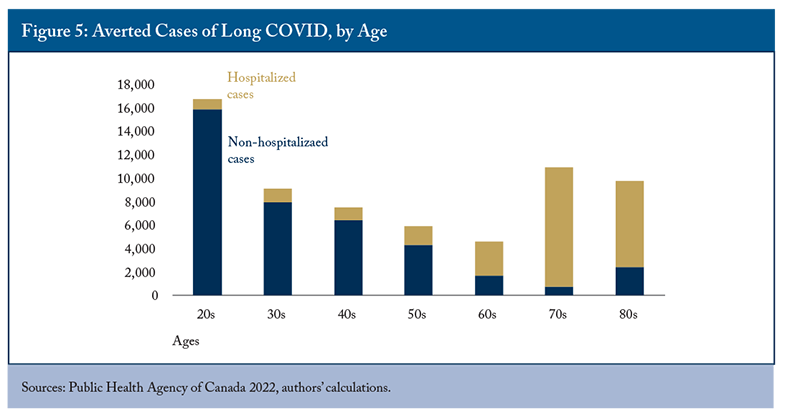
to 15 percent to 26 percent for patients that were admitted to hospitals and 27 percent to 42 percent for those admitted to intensive care (ranges represent estimates for men and women, respectively). This research suggests a disability weight (a standardized weighting factor that reflects the relative severity of a state of health) of 0.21 – “equivalent to complete hearing loss or severe traumatic brain injury (Else 2022).”
To estimate the number of long-COVID cases averted, we use the US estimates since they are based on the severity of disease. We assume that 3.5 percent of averted cases and 20.5 percent to 34.5 percent of averted hospitalizations would have resulted in a clinically significant long-COVID case.
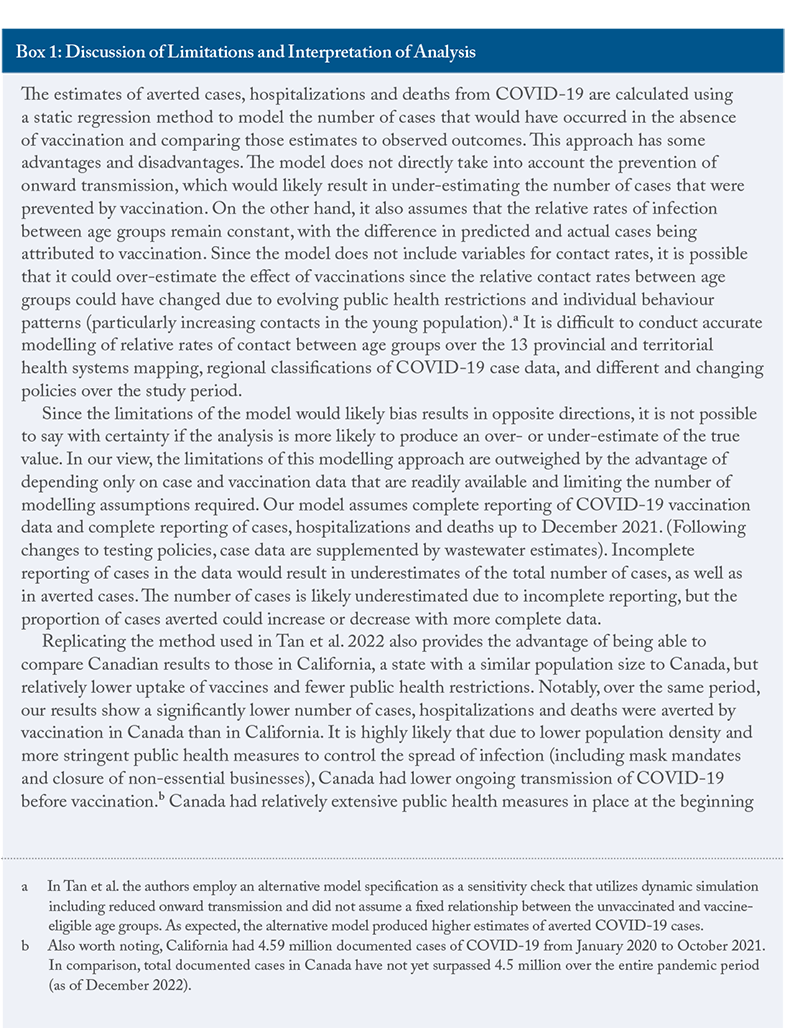
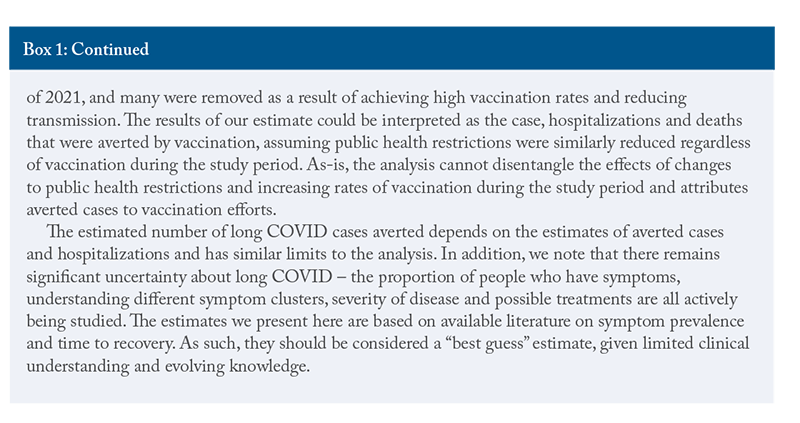
Estimating the Net Benefit of Vaccination
Vaccination has clearly had direct benefits for Canadians’ health– it has reduced the number of COVID-19 cases, hospitalizations and deaths. In this section, we estimate the direct benefits of vaccination by mapping averted COVID-19 cases, hospitalizations and deaths to the associated costs of lost wages, hospital admissions and the statistical value of life. The costs of the vaccination program include the spending on vaccines and resources related to vaccine distribution and administration.
Given the significant reduction in COVID-19 cases and severe outcomes of infection as a result of vaccines, they had indirect benefits as well in reducing the need for public-health infection prevention and control policies (particularly, restrictions on economic activity). These benefits are difficult to calculate, since provinces had different policies and thresholds for implementing various restrictions. Instead of estimating the aggregate costs and benefits of indirect effects of vaccination, we provide some illustrative examples.
At the time of writing, the COVID-19 pandemic has infected 4.3 million people, led to 187,949 hospitalizations

five to 15 working days.
To estimate the value of averted cases of long COVID, we depend on estimates from published research to make assumptions about duration of absences or reduced working hours and the cost associated with additional treatment. One survey found that 44 percent of people with long COVID were out of the labour force and 51 percent worked fewer hours, while other research found that 9 percent of people were unable to return to work three months after getting COVID-19 (Duong 2022). At three months post-infection, more than one in five experienced fatigue (22 percent), about one in six (16 percent) reported cognitive changes, one in 10 had headaches (11 percent), dyspnea (shortness of breath, 9 percent) or chest heaviness or pain and tightness (8.5 percent).
We estimate the value of reduced cases of long COVID as a simplified recovery timeline. We assume that all such cases would have stayed home from work initially for 15 working days (similar to regular cases of COVID). After that, we estimate half (51 percent) returning for reduced hours (20 hours per week), 44 percent remaining out of the labour force and the remaining 5 percent returning to work. As weeks progress, the proportion returning to full-time work adjusts linearly by 5.25 percent per week to 9 percent still remaining out of the labour force three months post infections. After 22 weeks, all long COVID cases are assumed to rejoin the labour market despite lingering symptoms in many cases.
Estimates show that vaccination prevented about 54,500 cases of long COVID in the working population (Figure 5). These cases would have represented about $331 million in lost wages as a result of extended time off work and reduced working hours.
In addition, those with prolonged symptoms require more treatment. To estimate the costs of this additional treatment, we use the estimated prevalence of the main conditions/symptoms associated with long COVID and available data about the treatment cost of those conditions.
We use estimates of the prevalence of the most common long-COVID symptoms and the costs of treatment by age group (where available) to calculate the savings associated with averted cases of long COVID. The treatment costs associated with the three most prevalent long-COVID symptoms (fatigue, headaches and cognitive changes, and difficulty breathing, chest pain or tightness) range from $2,250 to $5,000 per case and symptom. The estimated savings in the form of reduced treatment costs for long-COVID symptoms related to the nearly 65,000 averted cases are about $128 million.
Since the vaccines prevented many cases of COVID-19 and reduced the severity of the disease, they had a significant impact on mortality for the population more than 50 years of age, preventing about 30,900 deaths from the beginning of vaccination to May 2022. To translate this to figures comparable to other costs and benefits, we use the statistical value of life by age group from Chestnut and De Civita (2009), adjusted for inflation. With the statistical value of life ranging from $0.57 million (80+) to $2.23 million (60-69), the reduction in mortality associated with vaccination is equivalent to about $27.6 billion.
In summary, vaccination directly averted about $1.56 billion to $4.02 billion in lost wages and missed work, and saved about $1.77 billion in healthcare costs associated with treating COVID-19 patients. While these averted costs are significant, they are dwarfed by the $27.6 billion statistical value of the 30,900 lives saved by vaccination.
As of Oct. 9, 2022, 80.3 percent of Canadians had completed a primary series of a vaccine (two doses) and 56.6 percent of Canadians aged 12 and older had received at least one additional dose. To estimate the direct cost of vaccination efforts, we include publicly available information about the cost of vaccines, supplies used to administer them and information technology costs related to public health vaccination data.
The Government of Canada spent more than “$9 billion to procure vaccines and therapeutics and to provide international support.”
The cumulative number of all vaccine doses distributed in Canada was 100,019,578 as of July 21, 2022. This means $2.38 billion was spent on vaccine distribution.
As well, Canada ordered 286.9 million syringes to accommodate a range of requirements in the administration of vaccines. Syringes usually cost between $15 and $20 for a box of 100 depending on their source (Khan 2020), resulting in estimated total spending of $42.9 million to $57.4 million.
On behalf of the Public Health Agency of Canada (PHAC), Public Services and Procurement Canada contracted a service provider to “build further functionality into PHAC’s existing operational, surveillance and coverage information technology (IT) systems, to help manage vaccine rollout, administration and reporting as the volume of deliveries increases.” Such contracts cost $16,138,946, taxes included, on Jan. 7, 2021 (Government of Canada 2022).
There are other direct costs associated with vaccine administration including facilities, freezers and dry ice for transportation and storage, and labour costs. These costs would be extremely difficult to calculate accurately – billing rates differ by province and location of administration (public health vaccine centres, physicians’ offices or pharmacies). As well, capital directed to vaccine efforts was likely sourced in part from existing supplies and will be redirected to other purposes following COVID-19. To estimate these additional direct costs, we used the provincial billing rates and COVID-19 fee codes for family physicians to deliver a COVID-19 vaccine.
About 82.7 million vaccines had been administered in Canada by July 17, 2022, while more than 100 million vaccines had been distributed as of July 22. The difference can be accounted for by the doses currently in circulation – distributed, but not administered – and likely some doses that expired or were otherwise unusable and disposed of – distributed, but never administered.
Summary – Direct Costs and Benefits of Vaccination
Overall, the estimates of direct costs and benefits from vaccination show clear net benefit: the costs that would have occurred in the form of missed days of work and health spending associated with treatment and hospitalization likely exceeded the
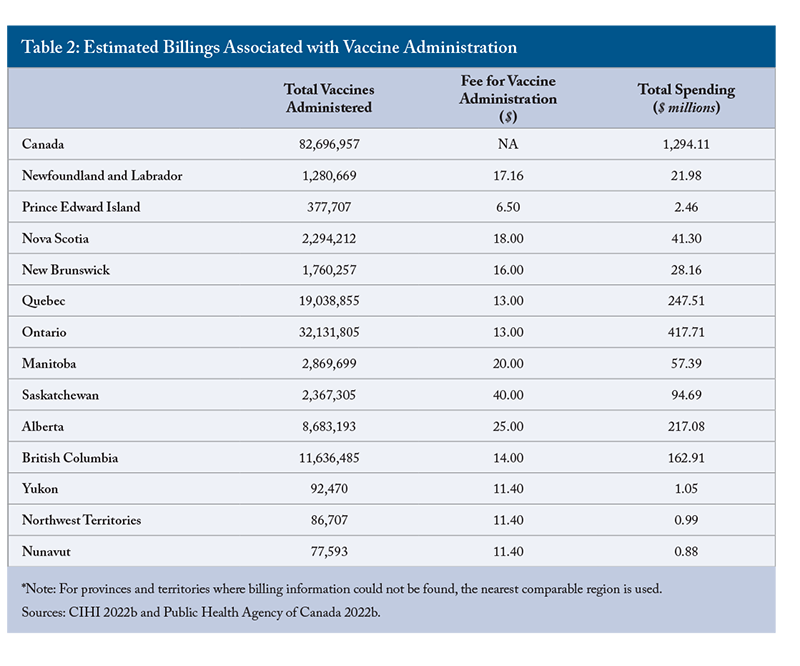
direct cost of vaccines and their administration. In addition, vaccinations reduced the number of deaths in the population older than 50 by about 34,900. In terms of statistical value of life, those saved lives are worth some $27.6 billion. Even without including lives saved, the vaccines show net cost/benefit of -$0.4 billion to $2.1 billion in averted costs (Table 3).
The scale and complexity of the pandemic, along with the associated public health policies to contain it, mean that there are many indirect costs and benefits related to vaccination. For example, vaccines enabled international travel for tourism and many economic activities to resume more normal operations. This was facilitated by the implementation of vaccine certificates, which required significant administrative efforts on the part of provincial governments and businesses that developed and implemented vaccination policies for workplaces, also at added cost. In addition, vaccination and associated policies had effects on political stability with the so-called “freedom convoy” created to protest vaccine mandates for the Canada-US border (though they evolved to protest COVID-19 mandates in general). It is generally beyond the scope of this Commentary to quantify these and other complex dynamics associated with
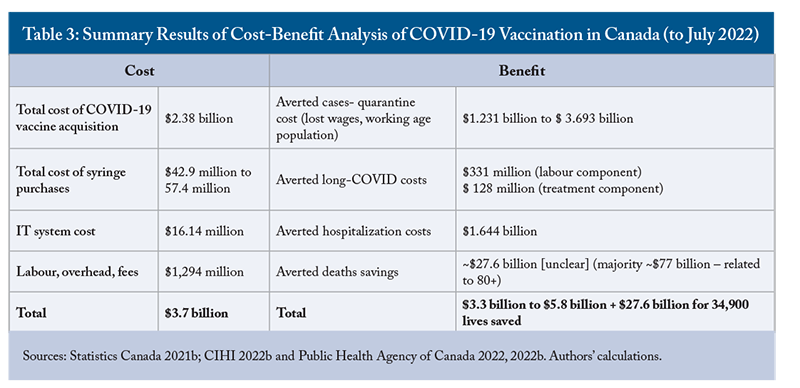
the indirect effects of vaccines in a comprehensive way. Instead, our goal here is to discuss some examples of the indirect effects and, where relevant and feasible, quantify their costs and benefits.
One of the most obvious results of vaccination is that many economic activities could regain some semblance of normal operation as the likelihood of another stay-at-home order and closure of non-essential businesses and high-contact activities became less likely. Had vaccination efforts been delayed, it is highly likely that there would have been additional public health restrictions, imposing additional economic costs. To estimate the economic effects that would have occurred if vaccine efforts had been delayed, we use modelling from Kronick and Jenkins (2021) who estimate the economic effects of uniform versus targeted lockdown strategies. They based their modelling approach on the work of Acemoglu et al. (2020), which was itself based on the epidemiological susceptible, infectious or recovered (SIR) modelling literature. Using a modified scenario that adjusts parameters to account for the different viral characteristics of Omicron and extends the time prior to vaccine availability by six months provides an estimate of the economic costs that would likely have occurred.
In addition, Kronick and Jenkins modelled two different lockdown strategies– a uniform approach and one that implemented different restrictions by age group. The reasoning for modelling different lockdown strategies is that most governments implemented uniform lockdowns, but research has shown that a targeted approach by age or industry would have achieved the same or better health outcomes with lower economic costs (Kronick and Jenkins 2021). If vaccines were not available, it is reasonable to assume that governments would continue to optimize and adapt public health policies. Modelling both a uniform and age-differentiated lockdown strategy accounts for the unknown of whether governments would have significantly adapted lockdown strategies to minimize economic impacts.
Results show that one year of continued Canadian public health restrictions pre-vaccination would have resulted in GDP losses of about 31.4 percent under a targeted strategy. Extending the pre-vaccine period by six months would have, unsurprisingly, resulted in worse economic outcomes: estimates suggest a 44 percent reduction in annual economic output. These results suggest that a six-month delay in vaccination availability would have resulted in economic losses equivalent to about 12.5 percent of GDP, or about $156 billion in 2021.
Vaccination and Indirect Public Health Benefits
Avoiding lockdowns and reducing the spread of COVID-19 through vaccination also has broader implications for health and well-being. Averting lockdowns means averting associated costs, including but not limited to reductions in civil liberty, reduced access to educational opportunities and social contacts, delayed medical procedures, forgone routine preventive health services (e.g., vaccination and cancer screenings), worsened domestic violence, worsened mental health and increased deaths from overdoses.
The longer-term effects of delayed medical procedures and forgone preventative and diagnostic activities are not yet known. However, the vaccines did have positive effects for the mental health of the population. According to Agrawal et al. (2021), COVID-19 vaccination led to a 28 percent reduction in anxiety and depression symptoms. Odihi et al. (2020) also discuss the indirect effects of vaccination in reducing fear of contagion and the severity of the disease, the equity effects of providing access to at-risk populations and the populations most affected by COVID-19 (lower income, higher proportion visible minority communities and vulnerable/immunocompromised individuals).
The development of vaccines and the scale of vaccination programs also generated positive spillover effects. Scientific knowledge about COVID viruses, vaccines, immunology and epidemiology has rapidly grown during the process of vaccine discovery and development. The RNA-based platform provides new opportunities for the development of other vaccines.
Discussion and Policy Implications
Overall, our analysis shows that COVID-19 vaccination averted an estimated 21 percent of cases and 37 percent of hospitalizations. From January 2021 to May 2022, this represents 1.19 million fewer cases of COVID-19 and 68,000 fewer hospitalizations. Furthermore, 63.5 percent of deaths in the population over age 50 were averted, representing about 34,900 lives saved from January 2021 to May 2022. Translating these findings to averted costs and comparing them to the cost of vaccines and vaccination programs shows that the vaccines are cost-effective. The cost of vaccines and administration were about $3.7 billion while the savings associated with averted cases and hospitalizations were estimated to be $3.3 billion to $5.8 billion, resulting in a net estimate of -$0.4 billion to $2.1 billion, without considering mortality. The statistical value of reduced mortality is about $27.6 billion, dwarfing the costs of the vaccines and savings associated with averting more minor cases.
Moreover, this analysis doesn’t include the indirect effects of vaccination. For example, vaccines reduce the need or intensity of future lockdowns, meaning vaccines likely averted additional costs associated with lockdowns, including the growth of healthcare waitlists, negative mental health impacts and reduced economic activity. Since these averted costs and other non-health benefits of vaccines are not included in our estimates of direct effects, the net benefit of vaccination is likely underestimated.
Many indirect effects of the COVID-19 vaccinations are difficult to quantify. However, a critical factor is public health policy related to the pandemic. If vaccines hadn’t been available, it is highly likely that further lockdowns would have been necessary, with all their associated costs. Lockdowns were necessary to disrupt the spread of COVID-19 prior to vaccination providing another pathway for reducing transmission. However, they had significant costs for the economy and the population’s mental health. We estimated the effect of delaying vaccines by six months, and results show that GDP would have dipped a further 12.5 percent.
Time is a critical factor in an ongoing crisis. The sooner COVID-19 is controlled, the sooner both the direct and indirect costs fall. The speed of development and distribution of not just one but many different vaccines for COVID-19 is truly an achievement for humanity. And it was accomplished in record time.
In normal times, it takes an average of more than 18 months after a drug has been approved by Health Canada to be listed on public drug plans. Indeed, in 2019 a new active substance submitted earlier to Health Canada had taken 554 days (18.2 months) to be listed on a public drug plan formulary and an additional 113 days (3.7 months) to be available to at least 50 percent of public plan beneficiaries (Dobrescu 2022). In 2021, it took even longer, 829 days (27.25 months) for a new active substance to be available on a public drug plan.
The time from submission to availability is a result of the many-layered sequential process of reviews before public drug plans make formulary listing decisions. The comparative speed of approval, procurement and access to COVID-19 vaccines occurred due to changes in the regulatory process that allowed for ongoing submission of new clinical data and regulatory processes to occur in parallel, rather than in sequence. This meant that submissions and evaluations for safety could begin while clinical trials were ongoing, and that reimbursement and procurement decisions could be made more quickly.
The scale of the pandemic necessitated emergency adaptations of regulatory policies to ensure rapid access to vaccines. However, an indirect future benefit in vaccination development could be improving regulatory processes to reduce the time from approval to reimbursement under public insurance plans. In 2021, parallel Health Canada and Health Technology Assessment reviews resulted in a listing recommendation 29 days faster than those conducted in sequence. There are lessons to be learned about parallel regulatory steps, price negotiations and reducing the time-to-patient for innovative medical products.
Clearly, Canada’s mass public vaccination programs were effective, resulting in one of the highest vaccination rates in the world. Most Canadians did not require encouragement to get vaccinated with many examples of people waiting in line for hours or constantly refreshing browsers in the hopes of receiving a jab.
However, continuing vaccine campaigns are necessary since the effectiveness of vaccines wanes over time. Two doses of COVID-19 vaccines appear to provide no protection against Omicron infections after six months and a third vaccine dose could increase efficacy to 61 percent (Duong and Vogel 2022). Given the mass nature of vaccination campaigns, large portions of the population will have waning immunity at the same time. Between March and October 2022, the third booster-dose uptake rate for people aged 12 and older remained consistently low at 56 percent. Only 11 percent of the population has received a fourth shot. The seasonal nature of COVID-19 and other infectious diseases (predominantly influenza) could pose a risk to an already strained and short-staffed hospital system if immunity levels in the population are allowed to decline.
It is crucial to improve overall COVID-19 booster and influenza vaccine uptake. Historically, influenza vaccination coverage among all adults was around 40 percent.
Achieving the rapid timeline of research, development, regulatory approval, production, procurement, distribution and administering vaccines is a collective success of scientists, public institutions, private industry and governments around the world. There are many lessons to be learned from the process, covering public policy areas from international trade and diplomacy to domestic regulatory processes and insurance negotiations. To ensure that Canada’s healthcare system is prepared for future COVID-19 surges, governments should prioritize maintaining high levels of population immunity on an ongoing basis through continued vaccination efforts, while also encouraging uptake or updates of other routine vaccinations.
In addition, federal and provincial governments should adapt regulatory processes and formulary decisions to reduce the time it takes for new medicines to go from market approval to being accessible to the public. The success of ongoing data submission and parallel processing of regulatory steps used for COVID-19 vaccines and treatments could serve as a template for adapting processes to take less time overall, or as a fast-tracking mechanism for high-priority products and treatments.
Overall, vaccines were highly effective at reducing COVID-19 cases, hospitalizations and deaths – resulting in an estimated 21 percent fewer cases, 37 percent fewer hospitalizations and preventing 34,900 deaths (as of May 2022). Vaccines along with less-deadly COVID-19 variants provided a route out of rotating lockdowns and uncertainty. While the vaccines and vaccination efforts were successful and cost-effective, the continuing threat of COVID-19 means that continued effort is needed to maintain high levels of population immunity. In addition, there are many lessons to be learned from the pandemic, public health restrictions and vaccination programs affecting long-term health and emergency preparedness policy.
References
Acemoglu, Daron, et al. 2020. “Optimal Targeted Lockdowns in a Multi-Group SIR Model.” National Bureau of Economic Research, Working Paper 27102. May.
Agrawal, Virat, et al. 2021. “The Impact of the COVID-19 Vaccine Distribution on Mental Health Outcomes.” National Bureau of Economic Research, Working Paper 29593. December.
Allen, Douglas W. 2021. “Covid-19 Lockdown Cost/Benefits: A Critical Assessment of the Literature.” International Journal of the Economics of Business 29(1): 1-32. September.
Andrews, Nick, et al. 2022. “Covid-19 Vaccine Effectiveness against the Omicron (B.1.1.529) Variant. New England Journal of Medicine. 386:1532-1546. April. Available at https://www.nejm.org/doi/full/10.1056/NEJMoa2119451
Aran, Dvir. 2021. “Estimating Real-world COVID-19 Vaccine Effectiveness in Israel Using Aggregated Counts.” medRxiv. February.
Bajema, Kristina L., et al. 2021. “Effectiveness of COVID-19 mRNA Vaccines Against COVID-19–Associated Hospitalization – Five Veterans Affairs Medical Centers, United States, February 1–August 6, 2021.” Morbidity and Mortality Weekly Report 70(37):1294–1299.
Barro, Robert J. 2022. “Vaccination Rates and COVID Outcomes across U.S. States.” National Bureau of Economic Research, Working Papers 29884. April.
Berry, Christopher R., et al. 2021. “Evaluating the Effects of Shelter-in-Place Policies during the COVID-19 Pandemic.” Proceedings of the National Academy of Sciences, 118(15): e2019706118. April.
Brown, Kevin A., et al. “Early Impact of Ontario’s COVID-19 Vaccine Rollout on Long-Term Care Home Residents and Health Care Workers.” Science Briefs of the Ontario COVID-19 Science Advisory Table 2(13). March.
Canada Institute for Health Information (CIHI). 2022. “COVID-19 Hospitalization and Emergency Department Statistics.” April. Available at https://www.cihi.ca/en/covid-19-hospitalization-and-emergency-department-statistics
______________. 2022b. “Physician billing codes in response to COVID-19.” April. Available at https://www.cihi.ca/en/physician-billing-codes-in-response-to-covid-19
Canadian Medical Association. 2021. “A struggling system: Understanding the health care impacts of the pandemic.” November. Available at https://www.cma.ca/sites/default/files/pdf/health-advocacy/Deloitte-report-nov2021-EN.pdf
Cohn, Barbara A., et al. 2022. “SARS-CoV-2 Vaccine Protection and Deaths among US Veterans during 2021.” Science 375(6578): 331-336. January.
Cutler, David M. 2022. “The Costs of Long COVID.” The Journal of the American Medical Association Forum. May. Available at https://jamanetwork.com/journals/jama-health-forum/fullarticle/2792505
Dagan, Noa, et al. “BNT162b2 mRNA Covid-19 Vaccine in a Nationwide Mass Vaccination Setting.” The New England Journal of Medicine 384:1412-1423. April.
Dave, Dhaval, et al. 2021. “When Do Shelter-in-Place Orders Fight Covid-19 Best? Policy Heterogeneity across States and Adoption Time.” Economic Inquiry 59(1)29–52. August.
Duong, Diana. 2022. “The evolving picture of long COVID.” Canadian Medical Association Journal, 194(24) E850-E851. June. Available at https://www.cmaj.ca/content/194/24/E850
Duong, Diana, and Lauren Vogel. 2022. “Booster Uptake Stalling as Experts Debate fourth COVID Shots.” Canadian Medical Association Journal 194(14): E532-533. April.
Else, Holly. 2022. “The pandemic’s true health cost: how much of our lives has COVID stolen? “Nature. May. Available at https://www.nature.com/articles/d41586-022-01341-7
Friedson, Andrew I., et al. 2020. “Did California’s Shelter-in-Place Order Work? Early Coronavirus-Related Public Health Effects.” National Bureau of Economic Research. April.
Griffin, Jennifer B., et al. 2021. “SARS-CoV-2 Infections and Hospitalizations Among Persons Aged ≥16 Years, by Vaccination Status – Los Angeles County, California, May 1- July 25, 2021.” Morbidity and Mortality Weekly Report 70(34):1170-1176. August.
Goldberg, Yair, et al. 2021. “Waning Immunity after the BNT162b2 Vaccine in Israel.” The New England Journal of Medicine 385:e85. December.
Government of Canada. 2022. “Procuring vaccines for COVID-19.” February. Available at https://www.canada.ca/en/public-services-procurement/services/procuring-vaccines-covid19.html
Haas, Eric J, et al. 2021. “Impact and Effectiveness of mRNA BNT162b2 Vaccine against SARS-CoV-2 Infections and COVID-19 Cases, Hospitalisations, and Deaths Following a Nationwide Vaccination Campaign in Israel: An Observational Study Using National Surveillance Data.” The Lancet 397(10287): 1819-1829. May.
Herby, Jonas, Lars Jonung, and Steve H. Hanke. 2022. “A Literature Review and Meta-Analysis of the Effects of Lockdowns on COVID-19 Mortality.” Studies in Applied Economics 200. January.
Khan, Nizam. 2020. “Insulin Prices: Pumps, Pens, Syringes, and More.” Healthline. March. Available at https://www.healthline.com/health/type-2-diabetes/insulin-prices-pumps-pens-syringes#insulin-vials-and-syringes
Kharroubi, Samer, and Fatima Saleh. 2020. “Are Lockdown Measures Effective Against COVID-19?” Front. Public Health 8:549692. October.
Kronick, Jeremy and Paul Jenkins. 2021. “From Here to Full Inoculation: How an Epidemiological Economic Model Can Help as We Roll Out Vaccines.” C. D. Howe Institute Working Paper. February. Available at https://www.cdhowe.org/sites/default/files/attachments/research_papers/mixed/Working%20Paper%20-%20From%20Here%20to%20Full%20Innoculation_0.pdf
May, Mike. 2021. “After COVID-19 successes, researchers push to develop mRNA vaccines for other diseases.” Nature Medicine 27(930-932). May. Available at https://www.nature.com/articles/s41591-021-01393-8
Mental Health Research Canada. 2020. “Mental Health in Crisis: How COVID-19 Is Impacting Canadians (Poll #1).” May. Available at https://static1.squarespace.com/static/5f31a311d93d0f2e28aaf04a/t/5f867fb52702a94f8015b958/1602650044612/Summary+Report+of+Key+Survey+Findings+-+FINAL.pdf
______________. 2021. “Mental Health in Crisis: How COVID-19 Is Impacting Canadians (Poll #6).” May. Available at https://static1.squarespace.com/static/5f31a311d93d0f2e28aaf04a/t/60cb4e65423079625bbf430a/1623936614551/MHRC+Covid+Poll+6+Report+-+Full+Version+-+Public+Release.pdf
Moghadas, Seyed M., et al. 2021. “The Impact of Vaccination on COVID-19 Outbreaks in the United States.” medRxiv [Preprint]. January.
Nourbakhsh, Shokfeh, et al. 2022. A wastewater-based epidemic model for SARS-Cov-2 with application to three Canadian cities. Epidemics. 39(100560): June. https://www.sciencedirect.com/science/article/pii/S1755436522000172
Odihi, Deborah, et al. 2020. “Economics of COVID-19 Vaccines.” Johns Hopkins Coronavirus Research Center. December. Available at https://coronavirus.jhu.edu/vaccines/report/economics-of-covid-19-vaccines
Plett, Donna, Petros Pechlivanoglou, and Peter C. Coyte. 2022. “The Impact of Provincial Lockdown Policies and COVID-19 Case and Mortality Rates on Anxiety in Canada.” Psychiatry Clinical Neurosciences. June.
Poeschl, Johannes, and Rasmus Bisgaard Larsen. 2021. “How Do Non-Pharmaceutical Interventions Affect the Spread of COVID-19? A Literature Review.” Nationalbanken Economic Memo 4:20. April.
Public Health Agency of Canada. 2022. “Update on COVID-19 in Canada: Epidemiology and Modelling.” January. Available at https://www.canada.ca/content/dam/phac-aspc/documents/services/diseases-maladies/coronavirus-disease-covid-19/epidemiological-economic-research-data/update-covid-19-canada-epidemiology-modelling-20220114-en.pdf
______________. 2022b. “COVID-19 vaccination in Canada”. Available at https://health-infobase.canada.ca/covid-19/vaccination-coverage/
Razak, Fahad, et al. 2022. “Canada’s Response to the Initial 2 years of the COVID-19 Pandemic: a Comparison with Peer Countries.” Canadian Medical Association Journal, 194(25) E870-E877. June.
Robinson, Lisa A., Ryan Sullivan, and Jason F. Shogren. 2020. “Do the Benefits of COVID-19 Policies Exceed the Costs? Exploring Uncertainties in the Age–VSL Relationship.” Risk analysis: An International Journal. July.
Rodrigues, Charlene M. C., and Stanley A. Plotkin. 2020. “Impact of Vaccines; Health, Economic and Social Perspectives.” Frontiers in Microbiology 11:1526. July.
Salek, Sam, et al. 2019. “Factors Influencing Delays in Patient Access to New Medicines in Canada: A Retrospective Study of Reimbursement Processes in Public Drug Plans.” Frontiers in Pharmacology. March. Available at https://www.frontiersin.org/articles/10.3389/fphar.2019.00196/full.
Santabárbara, Javier, et al. 2021. “Prevalence of anxiety in the COVID-19 pandemic: An updated meta-analysis of community-based studies.” Progress in Neuro-psychopharmacol & Biological Psychiatry 109:110207. July.
Statistics Canada. 2020. “COVID-19 in Canada: A Six-month Update on Social and Economic Impacts.” October. Available at https://www150.statcan.gc.ca/n1/pub/11-631-x/11-631-x2020003-eng.htm
______________. 2021. “COVID-19 in Canada: A One-year Update on Social and Economic Impacts.” March. Available at https://www150.statcan.gc.ca/n1/pub/11-631-x/11-631-x2021001-eng.htm
______________. 2021b. “Labour force characteristics by sex and detailed age group, annual”. Available at https://www150.statcan.gc.ca/t1/tbl1/en/tv.action?pid=1410032701
______________. 2022. “COVID-19 in Canada: A Two-year Update on Social and Economic Impacts.” March. Available at https://www150.statcan.gc.ca/n1/pub/11-631-x/11-631-x2022001-eng.htm
______________. 2022. “Canadian Economic Dashboard and COVID-19.” June. Available at https://www150.statcan.gc.ca/n1/pub/71-607-x/71-607-x2020009-eng.htm
______________2022. “Canadian Wastewater Survey, December 2021 to January 2022.” February. Available at https://www150.statcan.gc.ca/n1/daily-quotidien/220218/dq220218d-eng.htm
Suthar, Amitabh Bipin, et al. “Public Health Impact of Covid-19 Vaccines in the United States: Observational Study.” The British Medical Journal 377:e069317. March.
Tan, Sophia T., et al. 2022. “COVID-19 Vaccination and Estimated Public Health Impact in California.” JAMA Network Open 5(4): e228526. April.
Vogel, Lauren, and Diana Duong. 2021. “What’s the Evidence for COVID-19 Booster Shots?” Canadian Medical Association Journal, 193(35): E1400-1401. September.
Vilches, Thomas N., et al. “Projecting the Impact of a Two-dose COVID-19 Vaccination Campaign in Ontario, Canada.” Vaccine, 39(17): 2360-2365. April.
Watson, Oliver J., et al. 2022. “Global Impact of the First Year of COVID-19 Vaccination: A Mathematical Modelling Study.” The Lancet Infectious Disease. June.
Whitaker, Matthew, et al. 2021. “Persistent Symptoms Following SARS-CoV-2 Infection in a Random Community Sample of 508,707 people.” medRxiv [Preprint]. https://doi.org/10.1101/2021.06.28.21259452. July.
World Health Organization. 2021. “Clinical long-term effects of COVID-19.” March. Available at https://www.who.int/docs/default-source/coronaviruse/risk-comms-updates/update54_clinical_long_term_effects.pdf?sfvrsn=3e63eee5_8
Wyonch, Rosalie. 2021. Ounce of Prevention is Worth a Pound of Cure: Seniors’ Care After COVID-19. Commentary 614. Toronto: C.D. Howe Institute.December. Available at https://www.cdhowe.org/public-policy-research/ounce-prevention-worth-pound-cure-seniors-care-after-covid-19
Zaqouta, Ahmed, et al. 2021. “The Initial Impact of a National BNT162b2 mRNA COVID-19 Vaccine Rollout.” International Journal of Infectious Diseases 108: 116-118. July.







